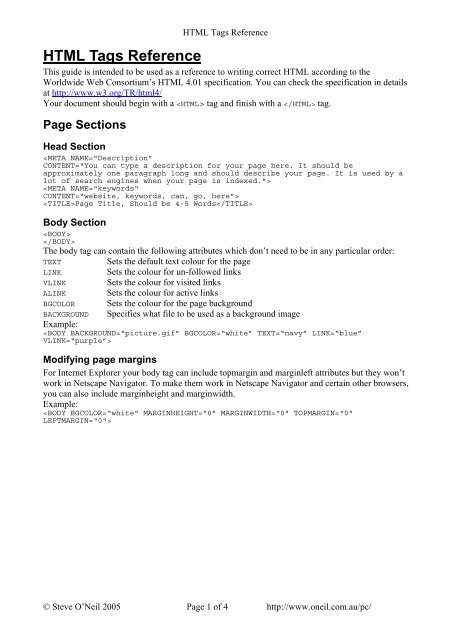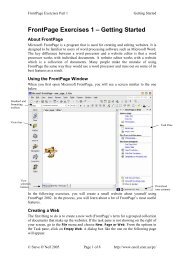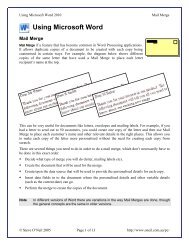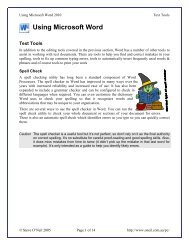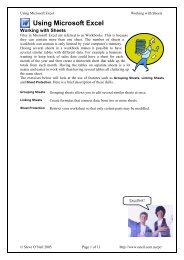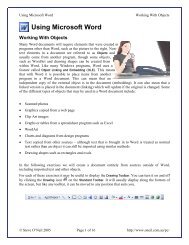HTML Tags Reference - oneil.com.au
HTML Tags Reference - oneil.com.au
HTML Tags Reference - oneil.com.au
Create successful ePaper yourself
Turn your PDF publications into a flip-book with our unique Google optimized e-Paper software.
<strong>HTML</strong> <strong>Tags</strong> <strong>Reference</strong><strong>HTML</strong> <strong>Tags</strong> <strong>Reference</strong>This guide is intended to be used as a reference to writing correct <strong>HTML</strong> according to theWorldwide Web Consortium’s <strong>HTML</strong> 4.01 specification. You can check the specification in detailsat http://www.w3.org/TR/html4/Your document should begin with a tag and finish with a tag.Page SectionsHead SectionPage Title, Should be 4-5 WordsBody SectionThe body tag can contain the following attributes which don’t need to be in any particular order:TEXT Sets the def<strong>au</strong>lt text colour for the pageLINK Sets the colour for un-followed linksVLINK Sets the colour for visited linksALINK Sets the colour for active linksBGCOLOR Sets the colour for the page backgroundBACKGROUND Specifies what file to be used as a background imageExample:Modifying page marginsFor Internet Explorer your body tag can include topmargin and marginleft attributes but they won’twork in Netscape Navigator. To make them work in Netscape Navigator and certain other browsers,you can also include marginheight and marginwidth.Example:
<strong>HTML</strong> <strong>Tags</strong> <strong>Reference</strong>Page ElementsBlock Level <strong>Tags</strong>Block tags are all tags that create a block of text on the page. The <strong>com</strong>mon ones are listed below.Paragraph The closing tag is optional since a web browser will assume that an opening paragraph tag meansany previous paragraphs are closed.Division A division groups sections of a page together but it can also be used like a paragraph except that a tag will create extra space between paragraphs. A tag won’t. Also, the closing tag is essential.Headings<strong>HTML</strong> has 6 levels of headings. The main heading should be a level one heading, subheadingsshould be level 2 etc. Bec<strong>au</strong>se a heading is a type of paragraph, there’s no need to include a tagfor a headingExamples:Main HeadingSub HeadingListsHere are three types of lists. These are Ordered lists (numbered lists), Unordered lists (bullet lists)and definition lists.Ordered ListsAn ordered list (numbered list) needs to have a tag before the list begins and a tag afterthe list finishes. Each paragraph in the list needs to begin with a list item tag instead of theusual tag.If you want your list to have letters or roman numerals instead of numbers, then you can include aTYPE attribute in your tag to specify the kind of list you want. The choices are 1, a, A, i, I..If you want to make your list start from a certain number you can include a START attribute whichspecifies the beginning number.Example:<strong>HTML</strong>First lineSecond lineThird lineResultV. First LineVI. Second LineVII. Third LineUnordered ListsUnordered lists (bulleted lists) are the same as ordered except that the OL tag is replaced with a ULtag. If you want to change the type of bullet then the choices for the TYPE attribute are disc(def<strong>au</strong>lt), square and circle. There is no START attribute.Example:<strong>HTML</strong>Result
<strong>HTML</strong> <strong>Tags</strong> <strong>Reference</strong>Definition ListDefinition lists begin with a tag and end with a closing tag. Each paragraph within thelist is either a definition term which starts with a tag, or a definition description which startswith a tag. The descriptions are usually indented in the web browser. These lists can be usedfor a lot more than just definitions as the following example shows.<strong>HTML</strong>MondayEnglishAuthoring PrinciplesTuesdayMathsResultMondayEnglishAuthoring PrinciplesTuesdayMathsAlignmentAny of the block level tags (P, Headings, DIV, LI, DT, DD) can be aligned on the page byincluding an align attribute. Example: Horizontal RulesYou can create a horizontal shaded line across the page to use as a divider by using the tag. Ithas the following attributes:NOSHADE The line will be solid instead of shadedSIZE The thickness of the line in pixelsWIDTH Width of the line on the page in pixels or % of page widthALIGNCOLORAlignment of the line on the page (left, center or right)Sets the colour of the line and makes it non-shaded. This is not a part of the<strong>HTML</strong> specification but works in most browsers.Example:© Steve O’Neil 2005 Page 3 of 4 http://www.<strong>oneil</strong>.<strong>com</strong>.<strong>au</strong>/pc/
Formatting <strong>Tags</strong><strong>HTML</strong> <strong>Tags</strong> <strong>Reference</strong> Bold text Italic text Underlined text or Strikethrough text Superscript text Subscript textThe Font TagThe font tag is often left out these days where styles are used instead since styles allow you greatercontrol over formatting. The formatting in a font tag is handled by three attributes listed below.SIZE This can be a number from 1 to 7 or it can be a relative amount, such as +2 whichwould mean 2 sizes larger than normal (normal text is usually size 3).COLORFACE`Changes the colour of the font.Specifies the font face. You can put more than one font name with a <strong>com</strong>mabetween each. This would mean that if a font specified in the tag isn’t installed ona <strong>com</strong>puter then the next font named will be used instead.Example:big green textSpecial <strong>HTML</strong> CharactersSome characters can’t be entered normally on a website bec<strong>au</strong>se they normally make up tags orbec<strong>au</strong>se they aren’t on your keyboard. These can all be entered on your page with special codes. Alist of some of the more <strong>com</strong>mon ones is shown below. blank space (non-breaking space) " “ Quotation marks> > Greater than sign < < Less than sign& & Ampersand © © Copyright symbol® ® Registered symbol &trade Trademark symbolA Few Rules and Things to Remember1. If you have more than one tag around a part of your page, the last one started must be the firstone closed.Correct example: Formatted textWrong Example: Formatted text2. Quote attributes correctly. Many tags will work with no quotes around attributes but not if onlyone side has quote. Example:Color=”red” is correctCOLOR=red is not correct but COLOR =red” or COLOR=”redwill workwill not work3. Make sure you close tags that need to be closed.4. If a tag has more than one attribute, they can go in any order you prefer. It won’t matter.5. Don’t always trust the way <strong>HTML</strong> is written on other websites. A lot of websites have badlywritten or incorrect <strong>HTML</strong>.© Steve O’Neil 2005 Page 4 of 4 http://www.<strong>oneil</strong>.<strong>com</strong>.<strong>au</strong>/pc/


